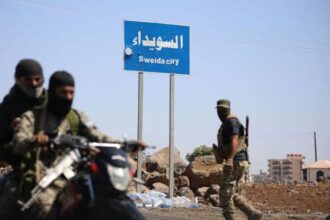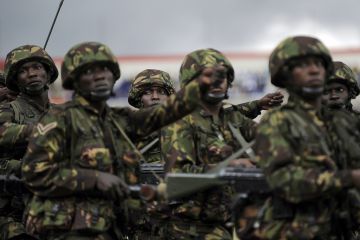
(Photo Palestinian Interior ministry handout)
Images of destruction, smoke billowing over Gaza’s sky, and a rising death toll, sometimes rising by dozens within 24 hours, made international news headlines in July and August.
Nearly four months after the end of the fighting, residents describe living conditions in the strip, the paralysed economy, the need for reconstruction, and the lack of a real governmental presence for citizens to raise their grievances.
The housing crisis in Gaza
“There has been a catastrophic deterioration of living conditions in the Gaza Strip” after the latest round of fighting, said the Director of the Economic and Social Rights Unit at the Palestinian Centre for Human Rights in Gaza, Khalil Shaheed.
Residents of the densely populated enclave wedged between Egypt and Israel have been forced to adapt to life under siege for years. The 2014 Israel-Gaza conflict further exacerbated the crisis.
Shaheed believes the most pressing need in the Gaza Strip is for construction materials.
Even though a donor conference in Cairo in September resulted in over $5bn of pledged international aid to rebuild the war-ravaged strip, Gaza resident Yasmin Saaqalla said “conditions are so difficult after the war. The destruction is still as it is”.
Economics professor at the Islamic University, Mohamed Ibrahim Migdad, used the same words to describe the destruction left behind after the war. “It remains as it is,” he said.
There are now 108,000 Gaza residents who need houses, down from 500,000 who were displaced at the height of fighting, according to figures by the United Nations Office for Coordination of Humanitarian Affairs (UNOCHA).
A reconstruction deal was announced by the UN Special Coordinator for the Middle East Peace Process, Robert Serry, on 16 September. The trilateral deal between Israel, the Palestinians, and the UN “gives the lead” to the Palestinian Authority to lead reconstruction and entails work at the “scale required in the Strip”, Serry said.
Israel has allowed some construction material through to Gaza. However, Migdad said the supplies are limited and do not meet the construction needs of Gaza.
“So far serious reconstruction has not begun,” Migdad said.
Shaheed estimated, however, that the mechanism included in the 16 September UN-sponsored agreement to reconstruct the strip would take 17 years to complete the reconstruction.
In the 50-day war in July and August 2014, the Gaza Strip was subject to intermittent bombing, shelling, and raiding. Israeli military operations included a ground invasion and daily aerial bombardments. Meanwhile, armed groups based the strip, including Hamas’ Qassam Brigades, fired thousands of rockets against civilian areas in Israel.
The effects of the fighting include damage to 18,000 houses, which were either destroyed or severely damaged, according to OCHA figures.
Some people have taken refuge in houses of relatives and others who were forced to seek shelter in UN schools as a result of the war, have remained there since. Migdad said this means up to dozens living in one classroom. He said others have returned to their ramshackle homes, which are likely to “collapse at any moment”. It is “tragic” he said adding that this is “not suitable for human habitation”.
As winter approaches, thousands of families are in dire need of shelter.
A rainstorm in November caused flooding in some areas and damaged homes, forcing some 200 families to leave, Shaheed said, only adding to Gaza’s housing crisis.
Shaheed said the housing crisis existed prior to the war last summer. He said there were already 70,000 people who needed homes prior to the most recent round of fighting.
At that stage, the housing crisis was the result of both natural population growth and the displacement of people as a result of previous rounds of fighting in Gaza, in 2008-2009 and in 2012.
Migdad said some partial reconstruction took place following the 2008-2009 war. It did not include rehabilitation of the damaged infrastructure or economy, whether its agricultural or industrial sectors but houses were rebuilt, he said. At that time, people relied on the illegal underground tunnels connecting Gaza to Egypt to import construction materials into the strip but supplies fell short of resolving the crisis.
Gaza has been under an Israeli land, air, and sea blockade since 2007. This was the year Hamas took over control of the strip, after months of infighting with Fatah.
The changes of power in Egypt in the past several years and the ouster of the Muslim Brotherhood regime in July 2013 brought about dramatic policy changes towards the tunnel trade, Egyptian security forces have carried out an intensive crackdown on the tunnels. By September 2014, the Egyptian armed forces said they destroyed over 1,700 tunnels.
These tunnels were used to admit food, medicine, fuel, and building materials. A report by the International Monetary Fund said tunnel demolition has had a “strong impact on the construction sector”.

(AFP Photo)
Social and economic impacts on people’s lives and restrictions on mobility
Migdad believes that the most important issues facing society in Gaza are unemployment and poverty.
“This makes citizens incapable of having food security. Items are available. The problem is people’s inability to buy,” he said.
Saaqalla said there are people who cannot find any food and others who have gone for months without any source of income.
According to the IMF, unemployment in Gaza “jumped to 45% in the second quarter of 2014 driven by a large loss of jobs in the construction sector”.
Of Gaza’s 1.8 million residents, over 1.2 million are refugees registered with the United Nations Relief and Works Agency (UNRWA). According to the UNRWA, 80% of Gaza’s population is dependent on international assistance.
Shaheed believes that restrictions on movement into and out of the strip have turned it into a consumerist society.
Gazans currently rely on the Rafah border crossing as the strip’s main entry and exit point but currently, the strip is seldom opened, which means that thousands are stranded on both sides. When it is opened, the strip is used by Gazans to reach Egypt and from there, they access the outside world.
The UNOCHA’s latest report on the period between 2 and 8 December states that the border crossing has now been shut for the longest period since mid-2008.
The crossing has been closed since attacks on Egyptian security forces on 24 October left 30 security personnel dead, with the exception of four days in which the crossing was opened in the direction of Gaza.
The UNOCHA’s latest report states that 3,242 out of an estimated 6,000 stranded on the Egyptian side were able to return to Gaza in those four days.
UNOCHA said this shutdown of the border crossing comes “despite appeals from human rights organisation and Palestinian political parties to re-open the crossing”.
Citing the Palestinian Border and Crossing Authority in Gaza, UNOCHA said there are around 10,000 registered people, including over a thousand medical patients waiting, to exit Gaza.
For years, patients in Gaza with more complicated conditions have sought treatment in Egyptian hospitals. But with no way to exit the strip, “many patients and children have died” Saaqalla said.
She added that many people have lost their jobs aboard because of their inability to leave the strip.
Shaheed believes that the restrictions on movement have also created a “rift in the Palestinian identity”. He said prior to Gazans’ reliance on the Rafah border crossing, people mainly relied on the Beit Hanoun or Erez border crossing in the North of the strip, which they used to reach the West Bank and from there, the outside world through Jordan.
Before the siege which started in 2007, Shaheed said, a quarter of students in West Bank universities were from Gaza. “Now it is 0%”, he said and added that the same goes for Gaza universities.
The fighting in the strip last summer damaged the Gaza power plant. Saaqalla said during the fighting, Gazans spent eight days without electricity. But after repairs to the strip’s sole power plant, Gazans currently alternate between having power for eight hours and then not having power for another eight.
Shaheed said people’s lives are programmed according to these power cuts.
These power cuts further worsen conditions inside Gaza’s strained hospitals.
UNOCHA described in its latest report “prolonged delays in access to treatment and increasing referrals sought outside of Gaza”. This is a result of multiple factors including, “chronic energy problems, a shortage of equipment and medication, and a lack of training opportunities for its staff, stemming, by and large, from years of blockade compounded by the large influx of injuries attributed to the July-August 2014 hostilities”.
For 12 days, cleaning companies working in the strip’s hospitals and healthcare facilities have been on strike, leading to piles of waste collecting inside. Health Ministry spokesman Ashraf Al-Qedra has repeatedly issued appeals ahead of the strike and after.
Al-Qedra said on 14 December that all surgical operations that were scheduled for the past 12 days have been halted until further notice because of the cleaning crisis. He added that this crisis has carried on without any intervention from the government or from relief providers.
Who is in charge in Gaza?
“Our situation in Gaza is exceptional,” Saaqalla said.
She said despite the fact that Hamas is in control and that security matters are in its hands, effectively “there is no government”. There is no official body that you can approach with your problems, she added.
Similarly, Migdad said there is “no real government”. He said Hamas’ role is very “weak”, adding that he believes that Hamas does not want to play a role in governing the strip.
On 23 April, Fatah and Hamas agreed on a unity government but Migdad said this government has not taken charge in Gaza, “despite the lack of an apparent reason for this”.
The unity government deal stipulated holding elections within six months and this has not taken place.
According to Ma’an news agency, Hamas and Fatah disagree on the interpretation of not holding elections. It cites Hamas spokesman Sami Abu Zuhrias saying that this means that “six-month mandate” of the government has “ended”. While Fatah senior official Faisal Abu Shahla is cited as saying that it was “never agreed that the government term would end if it did not complete those tasks within that time frame”.
Saaqalla said citizens are asking themselves who they should go to with their grievances.
Shaheed believes that the international community therefore bears “full responsibility” for the conditions inside Gaza.
The ceasefire and beyond
On 26 August, fighting came to an end, following an Egypt-brokered ceasefire. Since the ceasefire, four Palestinians were killed after the explosion of unexploded ordnance left behind from the fighting. According to UNOCHA, the deaths include a four year old child.
Migdad said people were optimistic after the Egypt-brokered ceasefire. The agreement stipulated opening of the crossings between Israel and the Gaza Strip for efficient reconstruction and the delivery of humanitarian aid to Gaza
Migadad said people were hopeful that the reconstruction would be swift. “This [hope] is completely switched off now. The agreement seems pointless,” he said.
Migdad believes the Egyptian side needs to pressure the Israeli side to commit to conditions in the agreement, the most important of which is reconstruction so “that people can feel some sense tranquillity, without living under the threats of rain and storms or ramshackle houses”.
Shaheed said the current situation in Gaza has created some “extremism”. He said some people are issuing statements bearing warnings, in which they claimed that they belong to the Islamic State of Iraq and Syria in Gaza.
In total more than 2,200 were killed during the fighting in Gaza last summer, according to figures provided by UNOCHA.
The death toll on the Palestinian side was 2,205. These include 1,483 civilians.
The death toll on the Israeli side was 71. These include 66 soldiers, a security coordinator, and four civilians, including a foreign worker.


